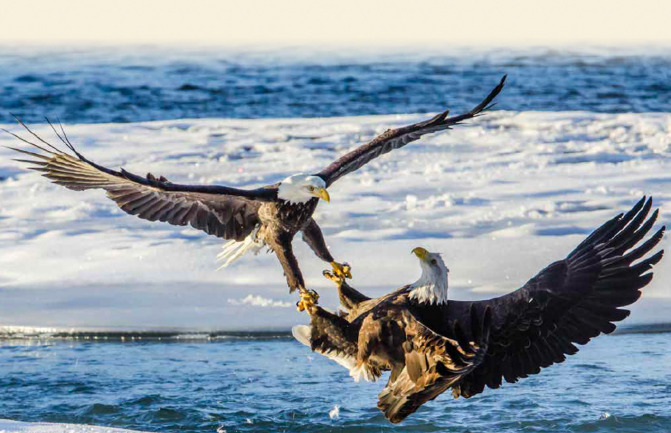
Photo courtesy of Joe Ordonez
Haines river guide, photographer and naturalist Joe Ordonez has been living and working in the Chilkat Valley since the 1980s, and wants to see it protected. Now he’s re-released his award-winning photography book ‘Where Eagles Gather’ on the story of the Alaska Chilkat Bald Eagle Preserve with a renewed emphasis on conservation. The new edition features a section opposing the proposed Palmer copper-zinc mining project moving forward at the headwaters of the Chilkat Valley. KHNS’ Corinne Smith sat down with him to talk about the book.
This interview has been edited for length and clarity.
KHNS: First of all, what inspired this book?
Joe Ordonez: I started guiding in the Chilkat Bald Eagle preserve in 1987. And I’ve just been fascinated, I was the training director for Chilkat Guides, and then for my own company, Rainbow Glacier Adventures. So I just really delved into the research on the eagle preserve, I learned everything I could about it, and was taking photos all along the way. And probably about 20 years ago, I said, boy, this would make a good book. And I should do it.
KHNS: It’s a beautiful photography book and walks through the natural history of the Chilkat Valley, as well as the cultural history. Can you talk a bit about, since the book was published in 2015, what has the public response been like?
Ordonez: Well, it’s been great. Right when it came out, we had a little bit of a marketing push for people just online…then doing the rafting tours in the Eagle Preserve. It’s a natural fit, we offer them to our guests on that tour. And a lot of them buy it you know at the end of the tour and take it home with them… So it’s been the response has been positive and you know, 3000 copies sold over a six year period. I had no idea really how it would sell and so I feel like that was a good pace, and so excited to be doing an update.
KHNS: So what’s new with this reprinted edition?
Ordonez: Well, I’ve been continuing to take photographs, and so I was able to update some of the photographs, like I got a great shot of the ptarmigan where you can kind of see how they have snowshoes, the way they get those extra feathers on their feet. I got a photo of a brown bear with, if you look carefully in his snout, you’ll see some porcupine quills. So that’s a new one. And one of them that I had, but it didn’t get in the first copy that I dug up, I said this that really has to be in the book. It’s a photograph of a raven, and a bald eagle on a salmon, eating it. And a group of ravens wanted to steal the salmon. And so the thing is, you know, what I talked about in the book – we think of the eagle in terms of strength and the ravens in terms of intelligence. So, one raven came from the side and actually grabbed that eagle by the tail feathers and started yanking on it, and I’ve captured that moment. And what happened after that is that the eagle got mad and turned to chase that raven away, and the other ravens came in from the other side, and stole and took bites of that salmon. So that’s a moment in time that I realized I had the photo I didn’t have in the first version of the book.
KHNS: There is a strong focus in the book on protection and conservation of this area and the unique and fragile ecosystems here, so can you talk a bit about the conservation message? Especially with the developments of Constantine’s Palmer Project, potentially moving into its next exploratory phase, potentially drilling a tunnel under the Saksaia Glacier in the next year? Can you talk about the potential risk to this area that you see?
Ordonez: Certainly, I just love the Eagle Preserve. I’ve spent so much time intimately associated with it as a photographer in the winter months with eagle gathering, and then as a river guide in the summer months. And then through all my research just found out how special and unique that the Eagle Preserve is. And one thing that happened recently is we’ve moved seasonally down to Mount Vernon, Washington, the Skagit River down there. I took a raft with me and did some exploration, and I actually was hired down there to do some bald eagle education. And I was along this river with cottonwoods that looked just like the Chilkat River, but there were no bald eagle nests. And last year, no eagles in the winter congregation. And I realized that river – with the upstream dams, the agriculture, the levees, the pollution, you know, all these things, everyone down there is just really trying to work together to save the last few of the salmon. That’s the river, the only river that has all five species of salmon running from Puget Sound. And here in this area, we’ve got a river, the Chilkat River hosts all five species of salmon, and fairly healthy runs. And so to have a mine upstream that would potentially, and I think likely, pollute the river. And just a small small bit of copper in the river caused the salmon to lose their honing abilities to find their home. And particularly since I wrote the book in 2015, the increasing extreme weather events and earthquakes…and, also population growth and all kinds of things. I mean, there really are not very many places that are as unspoiled as Haines and the Chilkat Bald Eagle Preserve. Over time, the more other places get spoiled, the more value the fact that the Eagle Preserve has not spoiled, the more value it has. Because scarcity equals value. So my position is, and the argument is economics a lot of times – people say well, the mine is going to bring money. But not having the mine is going to bring money. There’s already money moving through the community, because of eco-tourism. And so we have to look carefully at that. And as a community, you know, have some real discussions. You know, open discussions about the risks associated, we have decided as a community whether it’s worth it. But not only as a community, the Eagle Preserve is a treasure for Alaska, for the entire United States. And really for the world. It is unique.
It’s unique in the way all these rivers come together, the warm up with lifting, upwelling of water that give life to this November salmon run. Let one thing a lot of people don’t know is that the highest cause of eagle mortality is winter starvation. It gets cold, the salmon runs dry up. Matter of fact, if you see an adult bald eagle, it’s a one in ten survivor, nine of its generation died mostly of winter starvation. So the fact that there’s a November chum salmon run, a huge amount of biomass being flooded into the Chilkat Valley. The warm waters bring the salmon in, and then the salmon bring the eagles in. And that’s what held a key to the bald eagle survival.
I think we’re seeing all around us how the climate is changing, and how the planet is changing. So many of us are here because of the pure water and the fishing opportunities and the lifestyle that’s related to the subsistence part of our lifestyle. And not to mention the Natives who’ve been here for so long. And I don’t claim to speak for them, but I know they’re opposed to this. And so DOWA injected $8.8 million into this project, the Japanese, you know, out of country interest smelting corporation. And so I took $10,000 of my own dollars to self publish another 1,000 copies and help spread the word. So it’s a real David and Goliath sort of thing. But I truly believe in it. I also believe in the role that art can play and photography is art. And with beautiful imagery and well researched writing, and carefully crafted environmental advocacy, this is a dispute that can be won by the conservation community.
The hazard here is that the mine is upstream of the Eagle Preserve, the mine is upstream of Klukwan, the mine is upstream of Haines. And so you talk about the tunneling and the water permits in that there’s conductivity between upstream and downstream. This is basic physics, basic science, you know, it moves downstream, it moves down valley. I think it’s folly to think that a mine producing acid wastes, sulfuric acid mine drainage, upstream of the Eagle Preserve, and Klukwan and Haines won’t affect downstream. It will. And so that’s why I came out and said it on this version. I didn’t say the exact words (last time) but I added this time, I said, it’s a bad idea. This idea that, you know, I just think it’s folly to think these things can coexist. We have to protect what’s left. That’s how I feel.
KHNS: Yeah, a lot of important discussions to be had in this community in the next months and, and years. Thank you so much, Joe Ordonez, for your work and for this beautiful book, that captures a small slice of the beauty of the Chilkat Valley.
Ordonez: Thank you, Corinne
The updated version of his award-winning photography book ‘Where Eagles Gather: The Story of the Chilkat Bald Eagle Preserve is available now online here, in local bookstores and online retailers.








